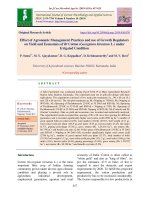INSECT GROWTH REGULATORS
Bạn đang xem bản rút gọn của tài liệu. Xem và tải ngay bản đầy đủ của tài liệu tại đây (250.13 KB, 7 trang )
Lecture 23: INSECT GROWTH REGULATORS
Insect Growth Regulators (IGRs) are compounds which interfere with the
growth, development and metamorphosis of insects. IGRs include synthetic analogues
of insect hormones such as ecdysoids and juvenoids and non-hormonal compounds
such as precocenes (Anti JH) and chitin synthesis inhibitors.
Natural hormones of insects which play a role in growth and development are
1. Brain hormone: The are also called activation hormone(AH). AH is secreted
by neuro secretory cells (NSC) which are neurons of central nervous system
(CNS). It’s role is to activate the corpora allata to produce juvenile hormone
(JH).
2. Juvenile hormone (JH): Also called neotinin. It is secreted by corpora allata
which are paired glands present behind insect brain. Their role is to keep the
larva in juvenile condition. JH I, JH II, JH III and JH IV have been identified
in different groups of insects. The concentration of JH decreases as the larva
grows and reaches pupal stage. JH I, II and IV are found in larva while JH III
is found in adult insects and are important for development of ovary in adult
females.
3. Ecdysone: Also called Moulting hormone (MH). Ecdysone is a steroid and is
secreted by Prothoracic Glands (PTG) present near prothoracic spiracles.
Moulting in insects is brought about only in the presence of ecdysone.
Ecdysone level decreases and is altogether absent in adult insects.
IGRs used in Pest management
a) Ecdysoids: These compunds are synthetic analogues of natural ecdysone. When
applied in insects, kill them by formation of defective cuticle. The development
processes are accelerated bypassing several normal events resulting in integument
lacking scales or wax layer.
b) Juvenoids (JH mimics) : They are synthetic analogues of Juvenile Hormone
(JH). They are most promising as hormonal insecticides. JH mimics were first
identified by Williams and Slama in the year 1966. They found that the paper
towel kept in a glass jar used for rearing a Pyrrhocoris bug caused the bug to die
before reaching adult stage. They named the factor from the paper as ‘paper
factor’ or ‘juvabione’. They found that the paper was manufactured from the
wood pulp of balsam fir tree (Abies balsamea) which contained the JH mimic.
Juvenoids have anti-metamorphic effect on immature stages of insect. They
retain status quo in insects (larva remains larva) and extra (super numerary)
moultings take place producing super larva, larval-pupal and pupal-adult
intermediates which cause death of insects. Juvenoids are larvicidal and ovicidal
in action and they disrupt diapause and inhibit embryogenesis in insects.
Methoprene is a JH mimic and is useful in the control of larva of hornfly, stored
tobacco pests, green house homopterans, red ants, leaf mining flies of vegetables
and flowers
c) Anti JH or Precocenes: they act by destroying corpora allata and preventing JH
synthesis. When treated on immature stages of insect, they skip one or two larval
instars and turn into tiny precocious adults. They can neither mate, nor oviposit
and die soon. Eg. EMD, FMev, and PB (Piperonyl Butoxide)
d) Chitin Synthesis inhibitors: Benzoyl phenyl ureas have been found to have the
ability of inhibiting chitin synthesis in vivo by blocking the activity of the enzyme
chitin synthetase. Two important compounds in this category are Diflubenzuron
(Dimilin) and Penfluron. The effects they produce on insects include
Disruption of moulting
Displacement of mandibles and labrum
Adult fails to escape from pupal skin and dies
Ovicidal effect.
Chitin sysnthesis inhibitors have been registered for use in many countries and
used successfully against pests of soybean, cotton, apple, fruits, vegetables, forest
trees and mosquitoes and pests of stored grain
IGRS from Neem : Leaf and seed extracts of neem which contains azadirachtin as
the active ingredient, when applied topically causes growth inhibition, malformation,
mortality and reduced fecundity in insects.
Hormone mimics from other living organisms: Ecdysoids from plants
(Phytoecdysones) have been reported from plants like mulberry, ferns and conifers.
Juvenoids have been reported from yeast, fungi, bacteria, protozoans, higher animals
and plants.
Advantages of Using IGRs
Effective in minute quantities and so are economical
Target specific and so safe to natural enemies
Bio-degradable, non-persistent and non-polluting
Non-toxic to humans, animals and plants
Disadvantages
Kills only certain stages of pest
Slow mode of action
Since they are chemicals possibility of build-up of resistance
Unstable in the environment
ANTIFEEDANTS
Antifeedants are chemicals that inhibit feeding in insects when applied on the foliage
(food) without impairing their appetite and gustatory receptors or driving (repelling)
them away from the food. They are also called gustatory repellents, feeding deterrents
and rejectants. Since do not feed on trated surface they die due to starvation.
Groups of antifeedants
Triazenes: AC 24055 has been the most widely used triazene which is a oduorless,
tasteless, non-toxic chemical which inhibit feeding in chewing insects like
caterpillars, cockroaches and beetles.
Organotins. They are compounds containing tin. Triphenyl tin acetate is an important
antifeedants in this group effective against cotton leaf worm, Colarado potato
beetle, caterpillars and grass hoppers
Carbamates: At sublethal doses thiocarbamates and phenyl carbamates act as
antifeedants of leaf feeding insects like caterpillars and Colarado potato beetle.
Baygon is a systemic antifeedants against cotton boll weevil.
Botanicals: Antifeedants from non-host plants of the pest can be used for their
control The following antifeedants are produced from plants.
Pyrethrum: Extracted from flowers of Chrysanthemum cinerarifolium acts as
antifeedants at low doses against biting fly, Glossina sp.
Neem: Extracted from leaves and fruits of neem (Azadirachta indica) is an
antifeedant against many chewing pests and desert locust in particular
Apple factor: Phlorizin is extracted from apple which is effective against nonapple feeding aphids.
Solanum alkaloids: Leptine, tomatine and solanine are alkaloids extracted
from Solanum plants and are antifeedants to leaf hoppers.
Miscellaneous compounds: Compounds like copper stearate, copper resinate,
mercuric chloride and Phosphon are good antifeedants.
Mode of action: Antifeedants inhibit the gustatory (taste) receptors of the mouth
region. Lacking the right gustatory stimulus the insect fails to recognize the trated leaf
as food. The insect slowly dies due to starvation.
Advantages:
Affect plant feeders, but safe to natural enemies
Pest not immediately killed, so natural enemies can feed on them
No phytotoxicity or pollution
Disadvantages
Only chewing insects killed and not sucking insects
Not effective as sole control measure, can be included in IPM
INSECT ATTRACTANTS
Chemicals that cause insects to make oriented movements towards their source
are called insect attractants. They influence both gustatory (taste) and olfactory
(smell) receptors.
Types of Attractants:
1. Pheromones: Pheromones are chemicals secreted into the external environment
by an animal which elicit a specific reaction in a receiving individual of the
same species.
2. Food lures : Chemical present in plants that attract insect for feeding. They
stimulate olfactory receptors.
List of natural and synthetic food lures
Insects
Pests of cruciferae
Onion fly (Hylemya antiqua)
Bark beetle
Housefly
Oriental fruitfly (Dacus dorsalis)
Melon fruitfly (Dacus cucurbitae)
Mediterranean fruitfly
(Ceratitis capitata)
Lure
Natural
Isothiocyanates from seeds of cruciferae
Propylmercaptan from onions
Terpenes from barks
Sugar and molasses
Synthetic
Methyl eugenol
Cuelure
Trimedlure
3. Oviposition lures: These are chemicals that govern the selection of suitable
sites for oviposition by insects. For example extracts of corn attracts
Helicoverpa armigera for egg laying on any treated surface.
Use of Attractants in IPM
Insect attractants are used in 3 ways in pest management
a) Sampling and monitoring pest population
b) Luring pests to insecticide coated traps or poison baits
Examples of poison baits
For biting insects: Moistened Bran + molasses) + insecticides
For sucking insects : Sugar solution + insecticide
For fruitflies: Trimedlure/ Cuelure/ Methyl eugenol + insecticides
For cockroaches: Sweet syrup + white or yellow phosphorus
For sweet-loving ants : Thallous sulphste + sugar + honey + glycerine +
water
For meat loving ants : Thallous sulphate + peanut butter
c) in distracting insects from normal mating, aggregation, feeding or oviposition
The female insects if lured to wrong plants for egg laying, the emerging larva will
starve to death
Advantage of using attractants is that they are specific to target insects and NE not
affected. But they cannot be relied as the sole method of control and can only be
included in IPM as a component.
INSECT REPELLENTS
Chemicals that induce avoiding (oriented) movements in insects away from
their source are called repellents. They prevent insect damage to plants or animals
by rendering them unattractive, unpalatable or offensive.
Types of repellents
1. Physical repellents : Produce repellence by physical means
a) Contact stimuli repellents: Substances like wax or oil when applied on leaf
surface changes physical texture of leaf which are disagreeable to insects
b) Auditory repellents: Amplified sound is helpful in repelling mosquitoes.
c) Barrier repellents: Tar bands on trees and mosquito nets are examples.
d) Visual repellents: Yellow light acts as visual repellents to some insects.
e) Feeding repellents: Antifeedants are feeding repellents. They inhibit feeding.
2. Chemical repellents:
a) Repellents of Plant origin: Essentials oils of Citronella, Camphor and
cedarwood act as repellents. Commercial mosquito repellent ‘Odomos’ uses
citronella oil extracted from lemongrass, Andrpogon pardus as repellent.
Pyrethrum extracted form Chrysanthemum is a good repellent and has been used
against tsetse fly, Glossina morsitans.
b) Synthetic repellents: Repellents synthetically produced.
List of important synthetic repellents
Insects
Mosquito, blood suckers
Mites (chiggers)
Crawling insects
Phytophagous insects
Wood feeders
Fabric eaters
Bees
Repellents
Dimethyl pthalate
Benzyl benzoate
Trichlorobenzene
Bordeaux mixture
Pentachlorophenol
Naphthalene or mothballs
Smoke
Uses of repellents:
They can be applied on body to ward off insects
Used as fumigants in enclosed area.
Used as sprays on domestic animals
To drive away insects from their breeding place.
BIORATIONAL CONTROL
Controlling insects using chemicals that affect insect behaviour, growth or
reproduction, is called biorational control.
Insect Growth Regulator,
Chitin synthesis inhibitor,
JH analogues, Anti JH,
Moulting hormone,
All these methods are included in
Pheromones
Biorational method of control
Allelochemics
Attractant, Repellent,
Antifeedant,
Chemosterilant,
Sterile male release
They are called biorational agents in pest control, because of their selective nature
in killing only the target insects without affecting non target organisms.
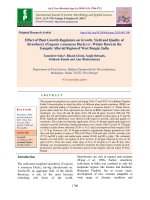
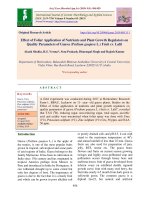
![Effect of different plant growth regulators on shooting of stem cuttings in dragon fruit [Hylocereus undatus (Haworth) Britton & Rose]](https://media.store123doc.com/images/document/2020_01/09/medium_isb1578564896.jpg)
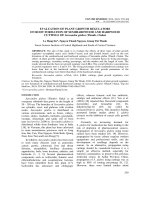
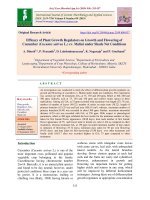
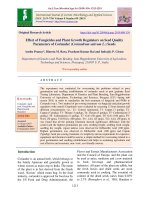

![Role of plant growth regulators on quality seed yield of bottle gourd [Lagenaria siceraria (Mol.) Standl.]](https://media.store123doc.com/images/document/2020_03/11/medium_cah1583900849.jpg)
![Effect of plant growth regulators on growth parameter s of taro [Colocasia esculenta var. antiquorum (L.) Schott.]](https://media.store123doc.com/images/document/2020_03/11/medium_jzz1583901063.jpg)
